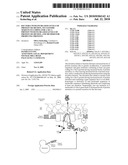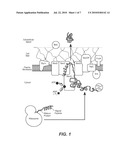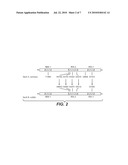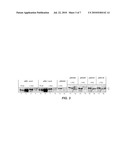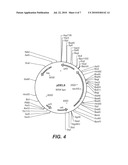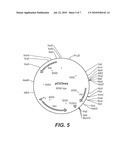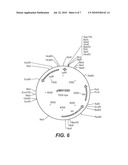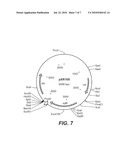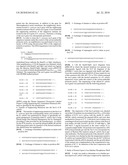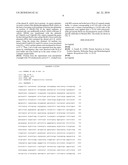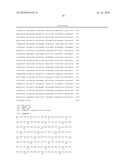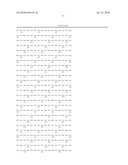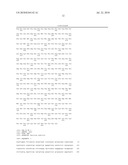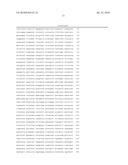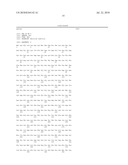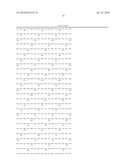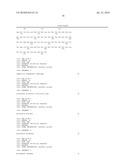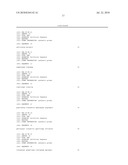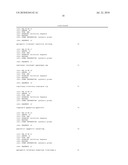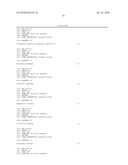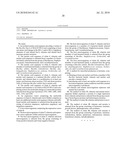Patent application title: BACTERIA WITH INCREASED LEVELS OF PROTEIN SECRETION, NUCLEOTIDE SEQUENCES CODING FOR A SECA PROTEIN WITH INCREASED LEVELS OF PROTEIN SECRETION, AND METHOD FOR PRODUCING PROTEINS
Inventors:
Oliver Koberling (Castelnuovo Berardenga, IT)
Roland Freudl (Duren, DE)
IPC8 Class: AC12P2100FI
USPC Class:
435 694
Class name: Micro-organism, tissue cell culture or enzyme using process to synthesize a desired chemical compound or composition recombinant dna technique included in method of making a protein or polypeptide hormones and fragments thereof
Publication date: 2010-07-22
Patent application number: 20100184142
Claims:
1. An isolated nucleic acid sequence encoding a variant of the Bacillus
SecA of SEQ ID NO:4 and comprising at least one amino acid change in the
IRA-1 and/or IRA-2 regulatory elements of said altered SecA, wherein said
altered SecA increases protein secretion.
2. The nucleic acid sequence of claim 1, wherein said nucleic acid sequence is obtained from a member of a bacterial family selected from the group of Bacillaceae, Staphylococcaceae, Enterobacteriaceae, and Corynebacteriaceae.
3. The nucleic acid sequence of claim 2, wherein said member of said bacterial family is selected from the group of Bacillus subtilis, Bacillus licheniformis, Bacillus amyloliquefaciens, Staphylococcus carnosus, Escherichia coli, and Corynebacterium glutamicum.
4. The nucleic acid sequence of claim 1, wherein said nucleic acid sequence is a mutated Bacillus subtilis SecA protein, and wherein there is a modification in at least one amino acid between about position 1392 and about position 2186 of wild-type Bacillus subtilis SecA nucleic acid.
5. The nucleic acid sequence of claim 1, wherein said nucleic acid sequence is set forth in SEQ ID NO:3 and comprising at least one nucleotide change at a nucleotide position selected from the group of positions 1392, 1403, 1404, 1460, 1461, 1592, and 2186.
6. An expression vector comprising the nucleotide sequence of claim 1, wherein said vector further comprises at least one additional nucleic acid sequence wherein said additional nucleic acid sequence is selected from the group consisting of selection sequences, replication sequences, and integration sequences.
7. A host microorganism comprising the expression vector of claim 6.
8. The host microorganism of claim 7, wherein said expression vector replicates within said host microorganism.
9. The host microorganism of claim 7, wherein said host microorganism is selected from the group consisting of Gram-positive bacteria and Gram-negative bacteria.
10. The host microorganism of claim 7, wherein said host microorganism is a member of a bacterial family selected from the group of Bacillaceae, Staphylococcaceae, Enterobacteriaceae, and Corynebacteriaceae.
11. The host microorganism of claim 10, wherein said member of said bacterial family is selected from the group consisting of Bacillus, Staphylococcus, Escherichia, and Corynebacterium.
12. The host microorganism of claim 11, wherein said member of said bacterial family is selected from the group consisting of Bacillus subtilis, Bacillus licheniformis, Bacillus amyloliquefaciens, Staphylococcus carnosus, Escherichia coli, and Corynebacterium glutamicum.
13. A method for microbial production of proteins, comprising:a) obtaining at least one nucleic acid from a member of the Bacillus bacterial family, wherein said nucleic acid encodes a mutant SecA;b) introducing said at least one nucleic acid sequence in a host microorganism, under conditions such that a mutant microorganism is produced;and wherein said mutant microorganism expresses said mutant SecA protein.
14. The method of claim 13, wherein said mutant microorganism further expresses a protein at a high expression level, wherein said protein is selected from the group consisting of homologous proteins and heterologous proteins.
15. The method of claim 14, wherein said protein is recovered.
16. The method of claim 15, wherein said protein is selected from the group consisting of hormones, enzymes, growth factors, pharmaproteins, and cytokines.
17. The method of claim 16, wherein said enzyme is selected from the group consisting of proteases, amylases, carbohydrase, lipases, epimerases, tautomerases, mutases, transferases, kinases, and phosphatases.
Description:
[0001]This invention relates to bacteria that on the basis of genetic
modification display increased secretion of proteins, nucleotide
sequences as well as plasmids that contain at least one gene, which codes
for a SecA protein with increased secretion for proteins, a SecA with
increased protein secretion as well as a method for the production of the
desired proteins using the invention-based bacteria.
[0002]Gram-positive bacteria (above all, various Bacillus species) can discharge proteins in large quantities into the surrounding culture medium. This ability has been used for a long time for the industrial procurement of a plurality of secreted enzymes (such as, for example, amylases, proteases, lipases). The production strains that are used in industry for these processes are optimized by repeated, non-directed mutagenesis and subsequence screening for an increased exoenzyme production, something that can lead to yields of several grams of enzyme per liter of culture supernatant. Most of the time, the causes of the increased productivities of these strains are not known. Various attempts to use gram-positive bacteria as host organisms for the secretory procurement of heterologous proteins frequently yielded only a disappointing result. The yields, thus obtained in the overwhelming majority of cases, turned out to be definitely less than the quantities that can be attained from the secretion of homologous exoproteins. One of the reasons for this is the inefficient or entirely missing transport of the heterologous protein via the cytoplasm membrane [1-4].
[0003]The transport of proteins via the bacterial plasma membrane is catalyzed via so-called Sec-translocase (FIG. 1). The latter consists of the integral membrane constituents SecY, SecE, SecG, SecD, SecF and YajC as well as the central component SecA that, as the so-called translocation ATPase, couples the energy of the ATP bond and hydrolysis to the translation of the polypeptide chain via the membrane [5, 6].
[0004]An efficient initiation of translocation of a secretory protein via the bacterial cytoplasm membrane requires the development of a functional complex consisting of at least the SecA protein, SecY and the export protein upon the membrane. As a consequence of these functional interactions as well as the exchange of ADP against ATP on the nucleotide bonding point 1 (NBS I) of SecA, a conformation change leads to a membrane insertion of SecA as well as the activation of the SecA ATPase activity and the initiation of translocation. The ATP hydrolysis on SecA is regulated by a double intramolecular mechanism. Investigations on Escherichia coli showed that in the free SecA, which is present cytosolically, the ATPase activity is down-regulated by the interactions of the regulatory elements IRA-1 and IRA-2 (intramolecular regulator of ATP hydrolysis) with NBS 1. It is assumed that the conformation change brought about on the basis of functional interactions between SecA and the export protein of SecA leads to a spatial removal of IRA-1 and IRA-2 from NBS 1, as a result of which, the SecA ATPase is activated [7, 8]. During the secretory procurement of heterologous proteins with gram-positive bacteria, the translocation can represent a restrictive step on the basis of quality control or "proofreading activity" of the translocase. This control mechanism is necessary for the cell in order--with respect to its own proteins--to slot into the secretion path only those that are intended for export out of the cytosol. As for the heterologous proteins that are not adapted to the foreign export apparatus in an optimum fashion, this quality control, however, can represent an essential restrictive step. The ability of the heterologous expert proteins in terms of activating the translocation ATPase activity of the SecA protein is most likely decisive as to whether and with what efficiency a membrane transport of the heterologous export protein takes place or whether and to what extent there is a rejection of the heterologous export protein by the quality control of the Sec-translocase.
[0005]It is therefore the object of the invention to provide nucleotide sequences, protein sequences, bacteria as well as a method by means of which one can facilitate a secretory procurement of proteins that will be improved when compared to past known microbiological processes.
[0006]Starting with the preamble of Claim 1, the problem is solved according to the invention with the features given in the characterizing part of Claim 1. Furthermore, the problem is solved according to the invention by starting with the preamble of Claim 11 with the features given in the characterizing part of Claim 11. The problem is furthermore solved according to the invention by starting with the preamble of Claim 21 with the features given in the characterizing part of Claim 21. The problem is also solved according to the invention by starting with the preamble of Claim 22 with the features given in the characterizing part of Claim 22. The problem is also solved according to the invention by starting with the preamble of Claim 23 with the features given in the characterizing part of Claim 23. Starting with the preamble of Claim 30, the problem is also solved according to the invention with the features given in the characterizing part of Claim 30. Furthermore, The problem is also solved according to the invention by starting with the preamble of Claim 31 with the features given in the characterizing part of Claim 31.
[0007]Using the invention-based nucleic acids as well as polypeptides, it is now possible to take proteins that so far were exported by the microorganisms only in small quantities or not at all and to obtain them in a secretory fashion with microorganisms or to make them with increased efficiency. Compared to the naturally occurring or gene-engineering unchanged nucleic acids, the invention-based nucleic acids code for a translocation ATPase, hereafter referred to as SecA, which causes or displays increased secretion for proteins. The term "increased secretion" is taken to mean a protein secretion that is increased when compared to the wild type of organisms or that is also possible for the first time. Furthermore, it is possible to provide microorganisms and methods by means of which one can facilitate a secretion and production of proteins with yields that are higher when compared to hitherto known microbial methods or that are possible for the first time.
[0008]Advantageous developments are given in the subclaims.
[0009]The object of the invention is a SecA protein (translocation ATPase) with an amino acid sequence, which, compared to the wild type SecA amino acid sequence, displays at least a change in the amino acid sequence or a modified form of these polypeptide sequences or isoforms, as a result of which, there is formed a SecA with increased secretion for proteins.
[0010]It was found quite surprisingly that a change (=exchange) of an amino acid of the amino acid sequence of the SecA protein will already lead to an increased secretion of proteins or to a secretion of proteins that will be possible for the first time. Several exchanged amino acids, for example, 2 to 7, however, can also bring about the increased secretion for proteins.
[0011]Changes in the area of the amino acid sequences that are responsible for the development of the regulatory elements IRA-1/IRA-2, or a modified form of these polypeptide sequences or isoforms thereof, turned out to be advantageous for the SecA with increased secretion for proteins, whereby in this case, the term "area" is intended to cover not only changes that are found precisely in the amino acid positions that are responsible for the development of the IRA-1/IRA-2 but also changes that, for example, are by 250 to 300 amino acids in front of or behind the particular amino acid positions for IRA-1 or IRA-2.
[0012]The positions of the invention-based changes in the amino acid sequence of SecA can be shifted within different microorganisms. For example, starting with the changes in the amino acid positions of SecA of Staphylococcus carnosus, one can also cover the changes in the amino acid sequence of the SecA of other microorganisms that correspond to these positions.
[0013]By means of a single change as well as by several changes in the area of the amino acid sequence that is responsible for the development of IRA-1 or IRA-2 as well as by combinations of changes in these areas, it was possible to obtain a SecA with increased secretion for proteins.
[0014]The invention-based polypeptides are distinguished by the following: They come from gram-positive or gram-negative bacteria, preferably from the family of the Bacillaceae, Staphylococcaceae, Enterobacteriaceae or Corynebacteriaceae, particularly preferably the genus Bacillus, Staphylococcus, Escherichia or Corynebacterium, particularly preferably the species of Bacillus subtilis, Bacillus licheniformis, Bacillus amyloliquefaciens, Staphylococcus carnosus, Escherichia coli or Corynebacterium glutamicum. Examples of bacterial in strain cultures that are obtainable from DSMZ (Deutsche Sammlung von Mikroorganismen and Zellkulturen GmbH/German Collection of Microorganisms and Cell Cultures Co., Braunschweig) are, for example, Bacillus subtilis 168 or Staphylococcus carnosus TM 300. The invention at hand is characterized in greater detail by the listing of the previously mentioned bacteria strains, although this is not intended to be a restrictive list.
[0015]In the case of Staphylococcus carnosus, the amino acid sequences that form the IRA-1 in SecA extend to positions 721 to 772 and for IRA-2 to positions 448 to 567.
[0016]In the case of Bacillus subtilis, the amino acids sequences that form the IRA-1 in SecA extend to positions 716 to 767 and for IRA-2 to positions 442 to 561.
[0017]In the Staphylococcus carnosus that is isolated from SecA protein, it turned out to be advantageous to make at least one change in the area of the amino acids from position 198 to 772 or a modified form of these polypeptide sequences or isoforms thereof.
[0018]In the SecA protein isolated from Bacillus subtilis, it turned out to be advantageous to make at least one change in the area of the amino acids from position 442 to 767 or a modified form of these polypeptide sequences or isoforms thereof.
[0019]The object of the invention is a SecA with increased secretion for proteins or a part thereof containing an amino acid sequence according to SEQ ID No. 2, which displays at least one change in the group of the amino acids in position 198, 470, 474, 493, 537, 665 and/or 734 or a modified form of these polypeptide sequences or isoforms thereof.
[0020]The following amino acid exchanges in the SecA of Staphylococcus carnosus provide to be successful by way of example (see FIG. 2):
Position 198: Tyrosine into histidinePosition 470: Histidine into glutaminePosition 474: Alanine into valinePosition 493: Alanine into valinePosition 537: Asparaginic acid into alaninePosition 665: Valine into glutamic acidPosition 734: Asparaginic acid into valine.
[0021]The invention at hand also relates to a SecA with increased secretion for proteins with an amino acid sequence according to SEQ ID No. 4, which displays at least one change from the group of amino acids in position 464, 468, 487, 531 and/or 729 or a modified form of these polypeptide sequences or isoforms thereof.
[0022]The following amino acid exchange in the SecA of Bacillus subtilis proved to be successful by way of example (see FIG. 2):
Position 464: Histidine into glutaminePosition 468: Alanine into valinePosition 487: Alanine into valinePosition 531: Asparaginic acid into alaninePosition 729: Asparaginic acid into valine
[0023]By isoforms, we mean proteins having the same or comparable action specificity, which, however, display a differing primary structure.
[0024]By modified forms according to the invention, we mean proteins where there are changes in the sequence, for example, on the C- or N-terminus of the polypeptide or in the area of conserved amino acids without, however, impairing the function of increased protein secretion. These changes can be made in the form of amino acid exchanges according to known methods.
[0025]The object of this invention includes polypeptides with the function of an SecA with increased secretion for proteins that are so altered in terms of their amino acid sequence that they can export homologous and/or heterologous proteins with increased activity out of the cells.
[0026]The object of this invention includes nucleic acids that code for a SecA with increased secretion of proteins containing a gene sequence secA, which in the secA gene, display at least one mutation or an allele, homologue or derivative of these nucleotide sequences or nucleotide sequences hybridizing with them.
[0027]It was now found quite surprisingly that already a mutation in a nucleotide of the secA gene leads to an increased secretion for proteins or to a secretion of proteins that would be possible for the first time. Several mutations, for example, 2 to 7, however, can also bring about the increased secretion of proteins.
[0028]At least one mutation in nucleotide areas that code for the regulatory elements IRA-1 and/or IRA-2 of the SecA proteins or an allele, homologue or derivative of these nucleotide sequences or nucleotide sequences hybridizing with them turned out to be advantageous for the expression of an SecA with increased secretion for proteins, where the term "area" is intended to cover not only mutations that lie precisely in the areas that code for IRA-1/IRA-2 but also mutations that, for example, are located 750 to 900 nucleotides before or after the areas that in each case code for IRA-1/IRA-2.
[0029]Both by means of a single mutation and by means of several mutations in the area of the nucleotide sequences that code for IRA-1 or IRA-2 as well as a combination of mutations in these areas, it was possible to bring about an increased export of proteins.
[0030]The invention-based nucleic acids are distinguished as follows: They are isolated from gram-positive or gram-negative bacteria such as, for example, from the family of Bacillaceae, Staphylococcaceae, Enterobacteriaceae or Corynebacteriaceae, preferably the genus of Bacillus, Staphylococcus, Escherichia or Corynebacterium, particularly preferably from Bacillus subtilis, Bacillus licheniformis or Bacillus amyloliquefaciens, Staphylococcus carnosus, Escherichia coli or Corynebacterium glutamicum. The invention at hand is characterized in greater detail by the listing of the abovementioned bacteria strains, which, however, is not intended as a restrictive list.
[0031]In the case of Staphylococcus carnosus, the nucleotide area that codes for IRA-1 extends to the nucleotides from position 2161 to 2316 and for IRA-2 from position 1342 to 1701 (see also SEQ ID No. 1).
[0032]In the case of Bacillus subtilis, the nucleotide area that codes for IRA-1 extends to the nucleotides from position 2146 to 2301 and for IRA-2 from position 1324 to 1683 (see also SEQ ID No. 3).
[0033]In the case of the nucleic acids isolated from Staphylococcus carnosus, it turned out advantageous to have at least one mutation in the area of the nucleotides from position 592 to 2210 or an allele, homologue or derivative of these nucleotide sequences or nucleotide sequences hybridizing with them.
[0034]In the case of the nucleic acids isolated from Bacillus subtilis, it turned out advantageous to have at least one mutation in the area of the nucleotides from position 1392 to 2186 or an allele, homologue or derivative of these nucleotide sequences or nucleotide sequences hybridizing with them.
[0035]Particularly advantageous was found to be a nucleic acid containing a secA gene according to SEQ ID No. 1, which displayed at least one mutation in the gene from the group of the nucleotides in position 592, 1410, 1421, 1478, 1610, 1994 and/or 2210 or an allele, homologue or derivative of these nucleotide sequences or nucleotide sequences hybridizing with them.
[0036]The following mutations turned out to be successful in the secA gene of Staphylococcus carnosus:
Position 592: T to C
Position 1410: T to A
Position 1421: C to T
Position 1478: C to T
Position 1610: A to C
Position 1994: T to A
Position 2210: A to T.
[0037]Also particularly advantageous was found to be a nucleic acid containing a secA gene according to SEQ ID No. 3, which displayed at least one mutation from the group of the nucleotides in position 1392, 1403, 1404, 1460, 1461, 1592 and/or 2186 or an allele, homologue or derivative of these nucleotide sequences or nucleotide sequences hybridizing with them.
[0038]The following mutations turned out to be successful in the secA gene of Bacillus subtilis:
Position 1392: T to A
Position 1403: C to T
Position 1404: G to T
Position 1460: C to T
Position 1461: G to T
Position 1592: A to C
Position 2186: A to T.
[0039]In contrast to the mutations in positions 1392, 1592 and 2186, the two mutations of the nucleotides in position 1403 and 1404 or 1460 and 1461 on the protein level in each case lead to the exchange of only one amino acid.
[0040]Using the invention-based nucleic acid, one can efficiently export proteins out of the cells that in the presence of an unchanged SecA are exported only to a minor extent or not at all. The invention-based nucleic acids that code for a SecA with increased secretions for proteins bring about an altered control mechanism of the SecA for the proteins that are slotted out of the cell. In particular, heterologous proteins that are not adapted to the export apparatus of the host cell in an optimum fashion can now be particularly successfully exported with the help of the invention-based secA sequence. But the export of homologous proteins can also be advantageously improved with the help of the altered secA sequence.
[0041]By a nucleic acid or a nucleic acid fragment, we mean, according to the invention, a polymer consisting of RNA or DNA that can be single-strand or double-strand and that can contain optionally natural, chemically synthesized, modified or artificial nucleotides. The DNA polymer concept here also includes the genomic DNA, cDNA or mixtures thereof.
[0042]By alleles according to the invention, we mean equivalent nucleotide sequences that code for SecA proteins with increased secretion for proteins. Equivalent sequences are those sequences which, in spite of a deviating nucleotide sequence, for example, caused by the degeneration of the genetic code, will still code for the SecA protein with the desired increased secretion for proteins. Equivalent nucleotide sequences thus comprise naturally occurring variants of the sequences described herein as well as artificial nucleotide sequences that are obtained, for example, by chemical synthesis and that are possibly adapted to the codon custom of the host organism.
[0043]By equivalent nucleotide sequences, we also mean sequences with mutations, in particular, natural or artificial mutations of an originally isolated sequence that continue to code for a SecA protein with increased secretion for proteins.
[0044]Mutations of the equivalents comprise substitutions, additions, deletions, exchanges or insertions of one or several nucleotide residues. This also includes so-called sense mutations that on the protein level can, for example, result in the exchange of conserved amino acids, which, however, do not lead to any basic change of the increased secretions of proteins of the invention-based SecA protein and thus are neutral in terms of function. That includes also changes of the nucleotide sequence that on the protein level relate to the C-terminus or N-terminus of a protein without, however, essentially impairing the function of the protein.
[0045]The invention at hand also covers those nucleotide sequences that one obtains by modification of the nucleotide sequence, resulting in corresponding derivatives. The objective of such a modification, for example, can be the further delimitation of the coding sequence contained therein or, for example, also the insertion of additional restriction enzyme interfaces.
[0046]The object of the invention at hand also includes artificial DNA sequences so long as they have the desired properties as described above. Such artificial DNA sequences can, for example, be determined by the re-translation of amino acid sequences by means of computer assisted programs. Particularly suitable are coding DNA sequences that were obtained by re-translation of a polypeptide sequence according to the codon use that is specific for the host organism. The specific codon utilization can easily be determined by an expert who is familiar with molecular genetic methods by computer analysis of other already known genes of the organism that is to be transformed.
[0047]By homologous sequences according to the invention, we mean those that are complementary for the invention-based nucleotide sequences and/or that hybridize with them. The "hybridizing sequences" concept according to the invention includes substantially similar nucleotide sequences from the group of DNA or RNA that, under known stringent conditions, enter into a specific interrelationship (bonding) with the previously mentioned nucleotide sequences. That includes also short nucleotide sequences with a length of, for example, 10 to 30, preferably 12 to 15 nucleotides. According to the invention, this, among other things, also covers so-called primers or probes.
[0048]According to the invention, that also includes the sequence areas that precede (structural genes) (5'- or upstream) and/or follow (3'- or downstream) the coding areas. This especially includes sequence areas with regulatory function. They can influence the transcription, the RNA stability or the RNA processing as well as the translation. Examples of regulatory sequences, among other things, are promoters, enhancers, operators, terminators, translation amplifiers or ribosome bonding points.
[0049]Basically, genes can be amplified and subsequently isolated by known methods such as, for example, the polymerase chain reaction (PCR) with the help of short synthetic nucleotide sequences (primers). The primers used are generally produced on the basis of known gene sequences resting on existing homologies in conserved areas of the genes and/or considering the GC content of the DNA of the microorganism that is to be investigated.
[0050]Another procedure for the isolation of coding nucleotide sequences is the complementation of so-called defect mutants that, at least in phenotypical terms, display a function loss in the activity of the gene to be investigated or of the corresponding protein. By "complementation," we mean the elimination of the gene defect of the mutant and extensive restoration of the original phenotype prior to mutagenesis, which is attained by the introduction of functional genes or gene fragments.
[0051]A conventional mutagenesis method for the production of defect mutants, for example, is the treatment of the bacterial cells with chemicals such as, for example, N-methyl-N-nitro-N-nitrosoguanidine or UV radiation. Such methods for triggering mutation are generally known and, among other things, can be followed up in Miller (A Short Course in Bacterial Genetics, A Laboratory Manual and Handbook for Escherichia coli and Related Bacteria (Cold Spring Harbor Laboratory Press, 1992)) or in the handbook "Manual of Methods for General Bacteriology" by the American Society for Bacteriology (Washington D.C., USA, 1981).
[0052]The object of the invention furthermore includes a gene structure containing at least one of the previously described nucleotide sequences that code for a SecA with increased secretion for proteins as well regulatory sequences that are tied in with them in operational terms, which control the expression of the coding sequences in the host cell. Corresponding gene structures, for example, can be chromosomes, plasmids, vectors, phages or other nucleotide sequences that are not closed in a circular manner.
[0053]The invention at hand relates to a vector containing a nucleotide sequence of the kind described previously and coding for a SecA with increased secretion for proteins, regulative nucleotide sequences that are operationally tied in with it as well as additional nucleotide sequences for the selection of transformed host cells, for replication within the host cell or for integration into the corresponding host cell genome.
[0054]Suitable as vectors are those that are replicated in bacteria such as, for example, pWH1520 [17], pCU3 or pXR100 (see also FIG. 5, 6 or 7). Other plasmid vectors can be used in a similar manner. This listing, however is not intended to be restrictive as regards the invention at hand.
[0055]Using the invention-based nucleic acid sequences, one can synthesize corresponding probes or also primers, and one can use them for amplifying and isolating preferably gram-positive bacterial, for example, with the help of genes from other microorganisms that are analogous to the PCR technique.
[0056]The object of the invention at hand thus also includes a probe for the identification and/or isolation of genes coding for proteins that participate in the export of proteins, whereby this probe is made starting with the invention-based nucleic acid sequences of the kind described earlier and contains a marking suitable for detection. The probe can be a segment out of the invention-based sequence, for example, out of a conserved area, which, for example, has a length of 10 to 30 or preferably 12 to 15 nucleotides and which can hybridize under stringent conditions specifically with homologous nucleotide sequences. Numerous suitable markings are known from the literature on the subject. Instructions for this purpose can be found by the expert, among other things, for example, in the handbook by Gait: Oligonucleotide Synthesis: A Practical Approach (IRL Press, Oxford, UK, 1984) and by Newton and Graham: PCR (Spektrum Akademischer Verlag/Publishers, Heidelberg, Germany, 1994) or, for example, in the handbook: "The DIG System Users Guide for Filter Hybridization" by Firma Roche Diagnostics/the Roche Diagnostics Company (Mannheim, Germany) and by Liebl et al. (International Journal of Systematic Bacteriology (1991) 41: 255-260).
[0057]The object of the invention at hand furthermore includes the transfer of at least one of the invention-based nucleic acid sequences or a part thereof coding for a SecA with increased secretion for proteins, an allele, homologue or derivative thereof into a host system. That also includes the transfer of an invention-based gene structure into a host system. This transfer of DNA into a host cell is accomplished according to gene engineering methods. As a preferred method, one might mention here the transformation and, especially in a preferred manner, the transfer of DNA by electroporation. Gram-positive host organisms proved to be particularly suitable. A transformed microorganism, resulting from a successfully performed nucleic acid transfer, will differ from the correspondingly non-transformed microorganism in that it contains nucleic acids of the kind according to the invention and can bring them to expression accordingly. As representative of a suitable host system, we might mention organisms of the genus of Bacillus or Staphylococcus and preferably the species of Bacillus subtilis, Bacillus licheniformis, Bacillus amyloliquefaciens or Staphylococcus carnosus. As culture medium, depending on the requirements, we find usable a complex medium such as, for example, LB Medium (T. Maniatis, E. F. Fritsch and J. Sambrook, Molecular Clonin [sic]: A Laboratory Manual, Cold Spring Harbor Laboratory, Cold Spring Harbor, N.Y., 1989)) or also a mineral salt medium such as, for example, CGXII medium (Keilhauer, C. et al., 1993, J. Bacteriol., 175: 5593-5603). After corresponding cultivation, the bacteria suspension can be harvested and can be used for further examination, for example, for transformation or isolation of nucleic acids according to currently customary methods. This procedure can analogously be applied also to other gram-positive or gram-negative bacteria strains. Bacteria of the family of Bacillus or Staphylococcus are preferred here as host systems. In a particularly preferred manner, one might mention here the species Bacillus subtilis, Bacillus licheniformis, Bacillus amyloliquefaciens or Staphylococcus carnosus.
[0058]Moreover, the invention at hand also includes bacteria strains as host systems that are distinguished as mutated or wild type strains suitable for protein production because their metabolism flow runs increasingly in the direction of a biosynthesis of proteins. Suitable according to the invention are also those microorganisms that are known to the expert from microbial production methods such as, for example, Enterobacteriaceae or Corynebacteriaceae.
[0059]As host organisms, one can also use microorganisms where one or several gene(s), coding for proteins, components or factors that are responsible for the transport of proteins through the bacterial plasma membrane, are so altered that, in addition to the invention-based SecA protein, they contribute to an increased transport of proteins through the plasma membrane. That, for example, could be the other known constituents (secY, secE, secG, secD, secF and yajC) of Sec-translocase. By way of example, we might mention here the host organisms of the family of Bacillus or Staphylococcus.
[0060]The invention at hand will be explained in greater detail by means of the selected examples referring to microorganisms, although it is in no way restricted by them.
[0061]The invention at hand furthermore relates to a genetically altered microorganism, containing in a replicable form an invention-based nucleic acid of the kind previously described.
[0062]The invention also comprises a genetically altered microorganism, containing in replicable form a gene structure or a vector of the kind previously described.
[0063]The object of the invention furthermore also includes a genetically altered microorganism, containing an invention-based polypeptide with the function of an increased secretion for proteins when compared to the microorganism that is accordingly not altered in genetic terms. An invention-based genetically altered microorganism is furthermore distinguished by the following: It is a gram-positive or gram-negative bacterium such as, for example, an organism from the family of the Bacillaceae, Staphylococcaceae, Enterobacteriaceae or Corynebacteriaceae, particularly preferably the genus of Bacillus or Staphylococcus. Particularly preferred, for example, are Bacillus subtilis, Bacillus licheniformis, Bacillus amyloliquefaciens or Staphylococcus carnosus.
[0064]The invention at hand furthermore relates to a method for the microbial production of proteins where at least one of the invention-based nucleic acids isolated from a gram-positive or gram-negative bacterium is transferred into a host organism or is generated there with the means known to the expert and is expressed there, where this genetically altered microorganism is employed for the microbial production of proteins and where the correspondingly formed protein is isolated out of the culture medium.
[0065]The genetically altered microorganism, made according to the invention, can be cultivated continuously or discontinuously by way of the batch method (set cultivation) or by the fed batch (feed method) or repeated fed batch methods (repetitive feed method) for the purpose of producing proteins. A summary of known cultivation methods can be found in the textbook by Chmiel (Bioprozesstechnik 1. Einfuehrung in die Bioverfahrenstechnik--Bioprocess technique 1. Introduction into Bioprocess Technique (Gustav Fischer Verlag/Publishers, Stuttgart, 1991)) or in the textbook by Storhas (Bioreaktoren and periphere Einrichtungen--Bioreactors and Peripheral Devices (Vieweg Verlag/Publishers, Braunschweig/Wiesbaden, 1994)).
[0066]The culture medium to be used for this purpose must suitably meet the requirements of the particular strains. Description of culture media of various microorganisms can be found in the handbook "Manual of Methods for General Bacteriology" of the American Society of Bacteriology (Washington D.C., USA, 1981). As a source of carbon, one might use sugars and carbohydrates such as, for example, glucose, saccharose, lactose, fructose, maltose, molases, starch and cellulose, oils and fats such as, for example, soybean oil, sunflower oil, peanut oil and coconut fat, fatty acids such as, for example, palmitinic acid, stearic acid and linoleic acid, alcohols such as, for example, glycerin and ethanol, and organic acids such as, for example, acetic acid. These substances can be used individually or as a mixture. As nitrogen source, one can employ organic nitrogen-containing compounds such as peptones, yeast extract, meat extract, malt extract, corn spring water, soybean flower and urea, or inorganic compounds such as ammonium sulfate, ammonium chloride, ammonium phosphate, ammonium carbonate and ammonium nitrate. The nitrogen sources can be used individually or as a mixture. As a phosphorus source, one can employ phosphoric acid, potassium dihydrogen phosphate or dipotassium hydrogen phosphate or the corresponding sodium-containing salts. The culture medium furthermore must contain metal salts such as, for example, magnesium sulfate or iron sulfate that are necessary for growth. Finally, one can employ essential growth substances such as amino acids and vitamins in addition to the abovementioned substances. Suitable preliminary stages can, moreover, be added to the culture medium. The substances to be used and listed can be added to the culture in the form of a one-time preparation or they can be fed-in suitably throughout cultivation.
[0067]To check the pH control of the culture, one can suitably employ basic compounds such as sodium hydroxide, potassium hydroxide, ammonia or ammonia water or acid compounds such as phosphoric acid or sulfuric acid. To check the foam development, one can employ anti-foaming agents such as, for example, fatty acid polyglycol esters. To maintain the stability of plasmids, one can add suitable selectively acting substances to the medium, for example, antibiotics. To maintain aerobic conditions, one introduces oxygen or oxygen-containing gas mixtures into the culture such as, for example, air. The temperature of the culture normally is between 30° C. and 38° C., and preferably it is 37° C. The culture is continued until a maximum of the desired protein has been formed. This objective is normally attained within 8 to 72 hours.
[0068]The proteins can be analyzed by activity determination, sequencing or electrophoresis.
[0069]The microorganisms that are the object of the invention at hand can, for example, make proteins from glucose, saccharose, lactose, mannose, fructose, maltose, molasses, starch, cellulose or from glycerin and ethanol. This may involve the already previously more thoroughly described representatives of the gram-positive or gram-negative bacteria. The microorganisms that are genetically altered according to the invention here are distinguished by increased protein secretion when compared to the correspondingly unchanged microorganisms (wild type) or the microorganisms that merely contain the vector without the gene insert. In a particular embodiment of the invention at hand, it is shown that the expression of the invention-based secA gene in the homologous Bacillus subtilis system (that is to say, all components of the Sec transport apparatus come from Bacillus subtilis) will result in an at least triple increase in protein accumulation in the medium when compared to the control strains. By overexpression of additional genes that have a positive effect upon the general metabolism of protein biosynthesis, one can expect an additional increase in protein production.
[0070]Using the invention-based method, one can make pharmaproteins, hormones, enzymes, growth factors or, for example, cytokines. In that way, for example, one can make proteases, amylases, carbohydrases, lipases, epimerases, tautomerases, mutases, transferases, kinases or phosphatases in a microbial manner.
[0071]By way of example, the figures show plasmids, a schematic overview of the Sec protein secretion apparatus, a representation of the SecA proteins with the invention-based mutations as well as an experimental evidence of the increased protein secretion using the invention-based nucleic acids.
[0072]The following are shown:
[0073]FIG. 1: Sec-Protein Secretion Apparatus of Gram-Positive Bacteria
[0074]FIG. 2: Diagram illustrating the SecA Proteins of S. carnosus and B. subtilis. Shown in the drawing are the suppressing mutations of S. carnosus SecA, which are obtained by means of selection. The mutations marked by arrows were transferred by specifically directed mutagenesis individually to the corresponding amino acid positions from the plasmid-coded B. subtilis SecA.
[0075]FIG. 3: Evidence of PhoB or PhoB L15Q by Means of Western Blot in Cell Extracts and Culture Supernatants of Bacillus subtilis DB 104 Strain in Case of Co-Expression of Plasmid-Coded PhoB or PhoB L15Q and Mutated SecA Proteins. The induction of the PhoB expression was accomplished with 0.5 mM IPTG, the SecA expression was induced with 0.2% xylose. p: PhoB L15Q precursor; m: Mature PhoB (significantly increased quantities are indicated with the arrow); L15Q: Variant of alkaline phosphatase PhoB, which, on the basis of an amino acid exchange of leucine into glutamine on position 15 in the signal sequence, is exported only very inefficiently in the unaltered Bacillus subtilis; pWA-secA: Empty vector; pWA+secA: Vector with wild type SecA; pWAX: Plasmid with invention-based mutation of the secA of Bacillus subtilis, X stands for one of the mutations in position 464, 468, 487, 531 or 729.
TABLE-US-00001 Trace Experimental Preparation 1 Cell extract; plasmid pWA - secA; PhoB unchanged 2 Supernatant; plasmid pWA - secA; PhoB unchanged 3 Cell extract; plasmid pWA - secA; L15Q 4 Supernatant; plasmid pWA - secA; L15Q 5 Cell extract; plasmid pWA + secA; PhoB unchanged 6 Supernatant; plasmid pWA + secA; PhoB unchanged 7 Cell extract; plasmid pWA + secA; L15Q 8 Supernatant; plasmid pWA + secA; L15Q 9 Cell extract; plasmid pWA464; L15Q 10 Supernatant; plasmid pWA464; L15Q 11 Cell extract; plasmid pWA468; L15Q 12 Supernatant; plasmid PWA468; L15Q 13 Cell extract; plasmid pWA487; L15Q 14 Supernatant; plasmid pWA487; L15Q 15 Cell extract; plasmid pWA531; L15Q 16 Supernatant; plasmid pWA531; L15Q 17 Cell extract; plasmid pWA729; L15Q 18 Supernatant; plasmid pWA 729; L15Q
[0076]FIG. 4: Plasmid Vector pDEL6; [0077]SecAS.c.: secA gene of Staphylococcus carnosus; [0078]cat: Chloramphenicol resistance gene; [0079]orf1 and orf3: Areas that are located in the chromosome of Bacillus subtilis before (orf1) or behind (orf3) the secA gene. These areas are used for exchanging the secA gene in the chromosome of Bacillus subtilis against the secA gene of Staphylococcus carnosus. [0080]bla: Gene sequence coding for β-lactamase.
[0081]FIG. 5: Plasmid Vector pCU3seq; (corresponding to the pEF1 plasmid from publication [19]) [0082]cat: chloramphenicol resistance gene [0083]P25/O: bacteriophages T5 promoter PN25/lac operator [0084]lacI: gene coding for lac repressor [0085]Pv: B. subtilis vegII promoter [0086]bla: β-lactamase.
[0087]FIG. 6: Plasmid Vector pWH1520 [0088]bla: β-lactamase [0089]tet: tetracycline resistance gene [0090]xylR: repressor gene of the xylose operon from Bacillus megaterium [0091]xylA: N-terminal fragment of xylose isomerase under the control of a xylose-inducible promoter.
[0092]FIG. 7: Plasmid Vector pXR100; [0093]bla: β-lactamase [0094]xylR: repressor gene of the xylose operon from Bacillus megaterium [0095]PxylA: xylose-inducible promoter of xylose isomerase [0096]cat: chloramphenicol resistance gene.
EXEMPLARY EMBODIMENTS
General Description
[0097]First of all, a Bacillus subtilis strain was constructed with an artificially increased quality control of the SecA protein (hereafter called RMA=replacement mutant SecA).
[0098]The strain was generated in that the Bacillus subtilis secA gene, lying on the chromosome, was exchanged against the secA gene of Staphylococcus carnosus. This exchange resulted in an artificially increased quality control of Sec-translocase. The heterologous protein OmpA from E. coli was used as a model protein. The artificially increased quality control of the SecA protein meant that the heterologous protein OmpA of E. coli was specifically excluded from export. Moreover, the RMA displayed a cold-sensitive growth (that is to say, no growth at 25° C.) as well as defects in the formation of spores and the development of natural competence.
[0099]In the following, suppressor mutants of the RMA were selected, which again can grow at 25° C. and/or which again have the ability for the formation of spores. The characterization of these suppressor mutants meant that in these mutants, changes had occurred in the foreign secA gene. The corresponding amino acid changes related above all to the two areas IRA-1 and IRA-2 that are involved in the regulation of ATP hydrolysis on the NBS-1 of SecA. The further characterization of the suppressor mutants, moreover, showed that the heterologous OmpA protein, which is almost completely excluded from export in the RMA, can be exported in a definitely better manner in the suppressor mutants. On the basis of comparisons with Escherichia coli SecA mutants from bibliography data [10], which partly were identical to the invention-based mutations in the secA gene or the invention-based changes in the amino acid sequence of the SecA protein on the corresponding positions, one may assume that the mutations, identified in the IRA elements of Staphylococcus carnosus SecA, weakened the repression of ATP hydrolysis on the NBS-1 in SecA, as a result of which, the basal ATPase activity was increased [9, 10]. The altered Staphylococcus carnosus SecA variants thus represent SecA proteins that permit a better export of normally inefficient or not at all exported heterologous proteins.
[0100]All of the RMA and the isolated suppressor mutants still have the foreign secA gene of Staphylococcus carnosus and thus still represent an artificial situation with a mixed Sec-translocase; therefore, in the following, the discovered changes (individually and also in combination) were transferred to the homologous Bacillus subtilis SecA. The co-expression of the mutated Bacillus subtilis SecA proteins with various inefficiently transported export proteins in Bacillus subtilis showed that also in the now homologous system (that is to say, all components of the Sec transport apparatus come from B. subtilis), one could observe an improved export of the examined proteins (shown in FIG. 3 using the example of an inefficiently exported variant of the alkaline phosphatase PhoB of B. subtilis).
1. Construction of the Bacillus subtilis SecA Exchange Mutant (RMA)
[0101]The pDEL6 plasmid, which was used for the construction of the RMA, was constructed as follows:
[0102]A pOrf3 plasmid was obtained by ligation of a 0.5 kb Asp718/Pst1 fragment of plasmid pMKL4 [11] into the plasmid pGEM3Z (Promega). A 2.4 kb Nsil/Pst1 fragment of plasmid pBO1 [12] was ligated into the pOrf3 plasmid, which was digested with Pst1. The secA gene of the resultant plasmid pDEL1 was exchanged by digestion with Spe1 and Sal1 against a 1.4 kb EcoR1/Sal1 fragment of pDG268 plasmid [13], which carries the gene for chloramphenicol acetyl transferase (cat) from which resulted the plasmid pDEL3. Subsequently, various secA gene were ligated into the plasmid pDEL3, which was digested with Sal1 and Pst1. The pDEL5 plasmid carries the B. subtilis secA gene, which was obtained by Sal1/Pst1 digestion from pMKL4 plasmid [11] as 2.5 kb fragment. The pDEL6 plasmid carries the S. carnosus secA gene, which was obtained by Sac1/Pst1 digestion from pMA2 plasmid [14] as 2.6 kb fragment. The pDEL6 fragment, which was used for the construction of the RMA, thus contains areas from five different plasmids: [0103]secA gene from plasmid pMA12 [0104]chloramphenicol resistance gene (cat) from plasmid pDG268 [0105]orf1 from plasmid pBO4 [0106]orf3 from plasmid pMKL4 [0107]residual area (lacZ and bla) from plasmid pGEM3Z.
[0108]The bacillus subtilis SecA exchange mutant (RMA) was obtained in that the wild type strain B. subtitles DB104 (his, nprR2, nprE18, ΔaprA3) [15] was transformed with the linearized plasmid pDEL6 and that clones were selected, which were able to grow in the presence of 10 μg/ml of chloramphenicol. The secA gene exchange was verified by Southern Blot analyses, whereby the B. subtilis or S. carnosus secA gene was used as probe.
2. Isolation of Suppressor Mutants of B. subtilis RMA
[0109]The B. subtilis RMA was used as parental strain in order to isolate suppressor mutants that again can grow at 25° C. or that can sporulate better than the RMA.
[0110]To isolate the cold-resistant suppressor mutants of the RMA, Lurai-Bertani (LB) medium was inoculated after addition of 10 μg/ml of chloramphenicol with 106 cells of RMA and was incubated for 48 hours at 25° C. Between 100 and 1,000 cells were plated out on LB agar plates and were incubated for another 24 hours at 25° C. As an alternative, 106 cells from a culture of RMA that was incubated overnight at 37° C. were plated out directly on LB agar plates and were incubated for 24 hours at 25° C. The stability of the mutation of the resultant suppressor mutants was examined in that the mutants, after inoculation and incubation at 37° C., also after renewed inoculation and incubation at 25° C., displayed additional growth.
[0111]To isolate suppressor mutants, which again can sporulate better than RMA, 5 ml of sporulation medium [16] 1:100 were inoculated with a washed overnight solution of RMA and were incubated for at least 24 hours at 37° C. 100 μl of the preparation was heated for 30 minutes at 80° C. after the addition of the same quantity of chloroform. The spores were plated out on LB agar plates and were incubated for 2 days at 25° C. Mutants that were able to grow under these selection conditions were isolated.
3. Cloning and Sequencing of the secA Gene of the Suppressor Mutants
[0112]B. subtilis DB 104 was used in order to differentiate whether the suppressing mutations of the suppressor mutants are located in the secA gene of S. carnosus or another gene of B. subtilis. For this purpose, B. subtilis DB 104 was transformed with chromosomal DNA of the suppressor mutants and the chloramphenicol-resistant clone was selected. The resultant transformants were tested to determine whether they can also grow at 25° C., in other words, they also had integrated into the chromosome, in addition to the gene for chloramphenicol acetyl transferase, the neighboring, downstream-located S. carnosus secA gene with the suppressing mutation instead of the B. subtilis secA gene. It was found that the suppressing mutations of the suppressor mutants are located in the secA gene of S. carnosus. Therefore, a cloning of the secA gene was subsequently performed.
[0113]In order to clone the S. carnosus secA gene of the suppressor mutants under the control of the xylose-inducible promoter xylA, an amplification was performed of secA by means of PCR using chromosomal DNA of the suppressor mutants as matrices. The following primers were used for this purpose:
TABLE-US-00002 SecAS.c.NBamH1 (5' CGGGATCCCAAAGGAGCGAACAGAATGGG 3') SecAS.c.CSph1 (5' ACATGCATGCATACAACTTACTATTTACCGCAGC 3')
(underlined bases indicate the BamH1 or Sph1 interfaces). After amplification, a 2.56 kb fragment was obtained, which was digested with BamH1 and Sph1 and which was ligated into the likewise BamH1/Sph1 digested vector pWH1520 [17], as a result of which, the plasmid pWEsecAS.c.Supp. were obtained. The sequencing of the secA genes was performed with IRD800 marked primers:
TABLE-US-00003 SecAS.c.H1 (5' AACTGCAACGATGCCGAC 3'), SecAS.c.H2 (5' GTGCTGATAAAGCTGAACG 3'), SecAS.c.H3 (5' AATTCCAACGAACCGTCC 3'), SecAs.c.H4 (5' GACAAGGTGACCGCGGAG 3'), SecAS.c.H5 (5' AAGGTAAAGATCGTGAGG 3') and SecAs.c.R5 (5' CTGTTCAAGTTCAATCCG 3')
(MWG) using the Thermo Sequenase Fluorescent Labeled Primer Cycling Sequencing Kit (Amersham Pharmacia Biotech) as specified by the manufacturer.4. Transfer of Suppressing Mutations into the SecA of B. subtilis
[0114]The transfer of suppressing mutations in the SecA of S. carnosus upon the corresponding amino acid residues in the B. subtilis was performed by means of specifically targeted mutagenesis of plasmid-coded B. subtilis SecA using QuickChange Site-Directed Mutagenesis Kit by Stratagene according to data provided by the manufacturers. As matrix for the PCR reaction, we used the plasmid pMKL40 and the following primer pairs for insertion of the desired mutations (the altered bases are underlined): [0115]1. Exchange of histidine to glutamine on amino acid position 464
TABLE-US-00004 [0115] 5' GTGTTAAATGCCAAAAACCAAGAACGTGAAGCGCAGATC 3' 5' GATCTGCGCTTCACGTTCTTGGTTTTTGGCATTTAACAC 3'
[0116]2. Exchange of alanine to valine on position 468
TABLE-US-00005 [0116] 5' CCATGAACGTGAAGTTCAGATCATTGAAGAGGCCGGCC 3' 5' GGCCGGCCTCTTCAATGATCTGAACTTCACGTTCATGG 3'
[0117]3. Exchange of alanine to valine on position 487
TABLE-US-00006 [0117] 5' CGATTGCGACTAACATGGTTGGGCGCGGAACGG 3' 5' CCGTTCCGCGCCCAACCATGTTAGTCGCAATCG 3'
[0118]4. Exchange of asparaginic acid to alanine on position 531
TABLE-US-00007 [0118] 5' CCGGACGTCAGGGAGCCCCGGGGATTACTC 3' 5' GAGTAATCCCCGGGGCTCCCTGACGTCCGG 3'
[0119]5. Exchange of asparaginic acid to valine on position 729
TABLE-US-00008 [0119]5' GGATGGATCATATTGTTGCGATGGATCAGCTCCGCCAAGGG 3' 5' CCCTTGGCGGAGCTGATCCATCGCAACAATATGATCCATCC 3'
[0120]A 1.86 kb SnaB1/Sph1 secA fragment from pMKL40 in which the desired mutation was present was subsequently ligated with the 8.67 kb fragment of the mWMKL1 vector that was digested with SnaB1 and Sph1. From this resulted the plasmid pWAX (X here stands for one of the constructs 464, 468, 487, 531 or 729), which contained the secA genes with the desired mutations in a B. subtilis expression vector under the control of the xylose-inducible promoter pxylA. The sequencing of the altered B. subtilis secA genes was performed with the following primers:
TABLE-US-00009 SecAB.s.H1 (5' GTACAGCTAAGACAGAGG 3'), SecAB.s.H2 (5' TTGACCGCTTCGGCATGG 3'), SecAB.s.H3 (5' AAGGGATTCACCTTCGTGC 3'), SecAB.s.R1 (5' TTTCCTTCCATCGTGCGG 3'), SecAB.s.R2 (5' TTCAGTAAGCTGTACAGC 3') and SecAB.s.R3 (5' TTTCCGTC ATGAAGCGCC 3').
[0121]The expression of the SecA proteins was checked out in that LB medium was inoculated at an OD600 of 0.4 after addition of 0.2% (w/v) xylose with the strains B. subtilis DB104, which contained the plasmid pWAx and were then incubated for 4 hours at 37° C. Cells from 2 ml of culture were centrifuged off and were boiled up after solution with 50 μl of lysis buffer (10 mM Tris/HCl, pH 8.0, 25 mM MgCl2, 200 mM NaCl, 5 mg/ml lysozyme) in the same volume of 2× Laemmli sample buffer. The proteins were separated in a 10% SDS polyacrylamide gel and the SecA was documented by means of Western Blot analysis using B. subtilis SecA-specific antibodies. The functional mode of the altered B. subtilis SecA proteins was checked in that the temperature-sensitive B. subtilis secA mutant NIG1152 (met, his, div341ts) [18] was transformed with the pWAX plasmids and the growth defect of the mutant was complemented at the nonpermissive temperature of 42° C. by induction of the SecA expression with 0.2% (w/v) xylose.
5. Study of Protein Export of an Alkaline Phosphatase PhoB
[0122]A study was made to determine as to whether protein export in B. subtilis wild type is improved by expression of the altered B. subtilis SecA proteins. As export substrate, we used a variant of the alkaline phosphatase PhoB, which, on the basis of an amino acid exchange of leucine into glutamine on position 15 (PhoBL15Q) in the signal sequence, is exported only very inefficiently in the B. subtilis wild type. B. subtilis DB104 was transformed with the plasmids pCU3phoB or pCU3phoBL15Q, which contained the genes for the wild type PhoB or the variant PhoBL15Q as well as the plasmids pWAx that contained the altered secA B. subtilis genes. Using the strains thus obtained, LB medium was mixed with 0.5 mM IGTG and 0.2% xylose, it was inoculated at an OD600 of 0.4, and the cultures were incubated for 4 hours at 37° C. Then, 2 ml of cells were separated from the supernatant by centrifugation, they were dissolved with 50 μl of lysis buffer and were boiled up in the same volume of 2× Laemmli sample buffer.
[0123]Proteins from the supernatants were precipitated overnight with 13% trichloracetic acid at 4° C., washed twice with 80% acetone and boiled up in 50 μl of Laemmli sample buffer. A volume corresponding to 0.2 OD cells of the cell extracts and a volume corresponding to 1.0 OD cells of the supernatants were applied upon a 12.5% SDS polyacrylamide gel and the PhoB was documented by means of PhoB-specific antibodies in Western Blot. The results are shown in FIG. 3.
BIBLIOGRAPHY
[in English]
[0124]. . . [0125]4. Freudl, R. (1998): Protein Secretion in Gram-Positive Bacteria: Molecular Bases and Biotechnological Aspects. Biospektrum 4 (No. 1): 29-33. [0126]. . .[in English]
Sequence CWU
1
2812535DNAStaphylococcus carnosus 1atgggttttt taacaaaaat tgttgacggc
aataagagag aaatcaaacg cctaagtaag 60caagctgaca aagtaatctc attagaagaa
gaaatgtcaa ttcttactga tgaagaaatt 120agaaataaaa caaaagcatt ccaagaaaga
ttgcaagcag aagaagatgt aagcaaacaa 180gataaaattt tagaagaaat attacctgaa
gcatttgcgc ttgtccgtga aggagctaaa 240cgtgtattta atatgacacc ttatccagtt
caaatcatgg gtggtatcgc cattcataat 300ggtgacattt cagaaatgag aacaggtgaa
ggtaaaacat taactgcaac gatgccgact 360tatttaaacg ccttagcagc acgtggtgtg
catgttatta cagtcaatga atacttggca 420agttctcaaa gagaagaaat ggccgagtta
tataatttcc ttggtttatc agtcggattg 480aacttgaaca gcttatcaac agaacaaaag
cgtgaagctt ataatgcaga tattacgtat 540agtacaaata atgaattagg cttcgactat
ttacgcgata acatggtgaa ttattcagaa 600gaacgtgtta tgcgtccgct tcatttcgct
atcattgatg aggtcgactc tattttaatc 660gatgaagcgc gtacaccatt gattatttca
ggggaagctg aaaaatcaac atctctttat 720acacaagcaa atgttttcgc taaaatgtta
aaagcagaag atgattataa ttatgatgaa 780aaaacaaaat cagtacaatt aacagatcaa
ggtgctgata aagctgaacg tatgttcaag 840ttagataact tatatgattt gaaaaacgtt
gatattatca cgcatatcaa tacagcatta 900cgtgctaact atacattgca acgcgatgta
gattacatgg ttgtagatgg agaagtattg 960attgtcgacc aatttacagg tcgaacaatg
ccaggtcgtc gattctctga aggacttcac 1020caagcgattg aggctaaaga aggggttcaa
attcaaaatg aatctaaaac aatggcttct 1080atcacattcc aaaactactt ccgtatgtat
aataaattag ccggtatgac aggtactgct 1140aaaacagagg aagaagaatt ccgtaacatt
tataatatga cagttacaca aattccaacg 1200aaccgtcctg ttcaacgtga agatagacct
gacttgattt tcatcagcca aaaaggcaag 1260ttcgatgctg ttgttgaaga tgttgttgaa
aaacataaaa aaggccaacc aattctttta 1320ggtactgtag cggttgaaac aagtgaatac
atttcacaac tattgaaaaa acgcggtgtg 1380cgtcatgatg tcttaaacgc taaaaaccat
gaacgcgaag ctgaaatcgt atctacagca 1440ggtcaaaaag gtgcagtcac aatcgcaaca
aacatggctg gtcgtggtac cgatattaaa 1500ttaggcgaag gtgttgaaga attaggcggc
cttgctgtta ttggtacaga acgtcatgaa 1560tcacgccgta tcgatgatca gttgcgtggt
cgttctggac gacaaggtga ccgcggagaa 1620agccgtttct atttatcatt acaagatgag
ttgatggtac gtttcggttc tgaacgtctg 1680caaaaaatga tgggccgatt aggtatggat
gactctacac cgattgaatc aaaaatggta 1740tctcgagctg ttgaatctgc acaaaaacgt
gttgaaggta acaacttcga tgcacgtaaa 1800cgtatcttag aatacgatga agttttacgt
aaacaacgtg aaatcattta tggtgaacgt 1860aataatatta tcgattcaga atcaagttct
gaattagtca ttacaatgat acgctctaca 1920ttagatcgtg caatcagtta ttatgtaaat
gaagaattgg aagaaattga ctatgcgccg 1980tttattaatt ttgtggaaga tgttttcttg
cacgaaggtg aagtcaaaga agatgaaatc 2040aaaggtaaag gtaaagatcg tgaggatatt
ttcgatacag tatgggctaa aattgaaaaa 2100gcttatgaag cacaaaaagc caatataccc
gaccaattca atgaattcga acgtatgatt 2160ttattacgtt ctattgatgg aagatggaca
gaccatatcg atacaatgga tcaattacgt 2220caaggtatcc atttacgttc atacggtcaa
caaaacccac ttcgcgacta tcaaaatgaa 2280gggcaccaac tatttgatac aatgatggtc
aatattgaag aagacgtcag caaatatatc 2340ttgaaatcaa ttatcacagt agatgatgat
attgaacgtg ataaagcaaa agaatatcaa 2400ggacaacatg tatcagctga agatggaaaa
gaaaaagtaa aaccgcaacc agttgttaaa 2460gataatcaca tcggaagaaa tgatccttgt
ccatgcggca gcggtaaaaa gtataaaaat 2520tgctgcggta aatag
25352844PRTStaphylococcus carnosus 2Met
Gly Phe Leu Thr Lys Ile Val Asp Gly Asn Lys Arg Glu Ile Lys1
5 10 15Arg Leu Ser Lys Gln Ala Asp
Lys Val Ile Ser Leu Glu Glu Glu Met 20 25
30Ser Ile Leu Thr Asp Glu Glu Ile Arg Asn Lys Thr Lys Ala
Phe Gln 35 40 45Glu Arg Leu Gln
Ala Glu Glu Asp Val Ser Lys Gln Asp Lys Ile Leu 50 55
60Glu Glu Ile Leu Pro Glu Ala Phe Ala Leu Val Arg Glu
Gly Ala Lys65 70 75
80Arg Val Phe Asn Met Thr Pro Tyr Pro Val Gln Ile Met Gly Gly Ile
85 90 95Ala Ile His Asn Gly Asp
Ile Ser Glu Met Arg Thr Gly Glu Gly Lys 100
105 110Thr Leu Thr Ala Thr Met Pro Thr Tyr Leu Asn Ala
Leu Ala Ala Arg 115 120 125Gly Val
His Val Ile Thr Val Asn Glu Tyr Leu Ala Ser Ser Gln Arg 130
135 140Glu Glu Met Ala Glu Leu Tyr Asn Phe Leu Gly
Leu Ser Val Gly Leu145 150 155
160Asn Leu Asn Ser Leu Ser Thr Glu Gln Lys Arg Glu Ala Tyr Asn Ala
165 170 175Asp Ile Thr Tyr
Ser Thr Asn Asn Glu Leu Gly Phe Asp Tyr Leu Arg 180
185 190Asp Asn Met Val Asn Tyr Ser Glu Glu Arg Val
Met Arg Pro Leu His 195 200 205Phe
Ala Ile Ile Asp Glu Val Asp Ser Ile Leu Ile Asp Glu Ala Arg 210
215 220Thr Pro Leu Ile Ile Ser Gly Glu Ala Glu
Lys Ser Thr Ser Leu Tyr225 230 235
240Thr Gln Ala Asn Val Phe Ala Lys Met Leu Lys Ala Glu Asp Asp
Tyr 245 250 255Asn Tyr Asp
Glu Lys Thr Lys Ser Val Gln Leu Thr Asp Gln Gly Ala 260
265 270Asp Lys Ala Glu Arg Met Phe Lys Leu Asp
Asn Leu Tyr Asp Leu Lys 275 280
285Asn Val Asp Ile Ile Thr His Ile Asn Thr Ala Leu Arg Ala Asn Tyr 290
295 300Thr Leu Gln Arg Asp Val Asp Tyr
Met Val Val Asp Gly Glu Val Leu305 310
315 320Ile Val Asp Gln Phe Thr Gly Arg Thr Met Pro Gly
Arg Arg Phe Ser 325 330
335Glu Gly Leu His Gln Ala Ile Glu Ala Lys Glu Gly Val Gln Ile Gln
340 345 350Asn Glu Ser Lys Thr Met
Ala Ser Ile Thr Phe Gln Asn Tyr Phe Arg 355 360
365Met Tyr Asn Lys Leu Ala Gly Met Thr Gly Thr Ala Lys Thr
Glu Glu 370 375 380Glu Glu Phe Arg Asn
Ile Tyr Asn Met Thr Val Thr Gln Ile Pro Thr385 390
395 400Asn Arg Pro Val Gln Arg Glu Asp Arg Pro
Asp Leu Ile Phe Ile Ser 405 410
415Gln Lys Gly Lys Phe Asp Ala Val Val Glu Asp Val Val Glu Lys His
420 425 430Lys Lys Gly Gln Pro
Ile Leu Leu Gly Thr Val Ala Val Glu Thr Ser 435
440 445Glu Tyr Ile Ser Gln Leu Leu Lys Lys Arg Gly Val
Arg His Asp Val 450 455 460Leu Asn Ala
Lys Asn His Glu Arg Glu Ala Glu Ile Val Ser Thr Ala465
470 475 480Gly Gln Lys Gly Ala Val Thr
Ile Ala Thr Asn Met Ala Gly Arg Gly 485
490 495Thr Asp Ile Lys Leu Gly Glu Gly Val Glu Glu Leu
Gly Gly Leu Ala 500 505 510Val
Ile Gly Thr Glu Arg His Glu Ser Arg Arg Ile Asp Asp Gln Leu 515
520 525Arg Gly Arg Ser Gly Arg Gln Gly Asp
Arg Gly Glu Ser Arg Phe Tyr 530 535
540Leu Ser Leu Gln Asp Glu Leu Met Val Arg Phe Gly Ser Glu Arg Leu545
550 555 560Gln Lys Met Met
Gly Arg Leu Gly Met Asp Asp Ser Thr Pro Ile Glu 565
570 575Ser Lys Met Val Ser Arg Ala Val Glu Ser
Ala Gln Lys Arg Val Glu 580 585
590Gly Asn Asn Phe Asp Ala Arg Lys Arg Ile Leu Glu Tyr Asp Glu Val
595 600 605Leu Arg Lys Gln Arg Glu Ile
Ile Tyr Gly Glu Arg Asn Asn Ile Ile 610 615
620Asp Ser Glu Ser Ser Ser Glu Leu Val Ile Thr Met Ile Arg Ser
Thr625 630 635 640Leu Asp
Arg Ala Ile Ser Tyr Tyr Val Asn Glu Glu Leu Glu Glu Ile
645 650 655Asp Tyr Ala Pro Phe Ile Asn
Phe Val Glu Asp Val Phe Leu His Glu 660 665
670Gly Glu Val Lys Glu Asp Glu Ile Lys Gly Lys Gly Lys Asp
Arg Glu 675 680 685Asp Ile Phe Asp
Thr Val Trp Ala Lys Ile Glu Lys Ala Tyr Glu Ala 690
695 700Gln Lys Ala Asn Ile Pro Asp Gln Phe Asn Glu Phe
Glu Arg Met Ile705 710 715
720Leu Leu Arg Ser Ile Asp Gly Arg Trp Thr Asp His Ile Asp Thr Met
725 730 735Asp Gln Leu Arg Gln
Gly Ile His Leu Arg Ser Tyr Gly Gln Gln Asn 740
745 750Pro Leu Arg Asp Tyr Gln Asn Glu Gly His Gln Leu
Phe Asp Thr Met 755 760 765Met Val
Asn Ile Glu Glu Asp Val Ser Lys Tyr Ile Leu Lys Ser Ile 770
775 780Ile Thr Val Asp Asp Asp Ile Glu Arg Asp Lys
Ala Lys Glu Tyr Gln785 790 795
800Gly Gln His Val Ser Ala Glu Asp Gly Lys Glu Lys Val Lys Pro Gln
805 810 815Pro Val Val Lys
Asp Asn His Ile Gly Arg Asn Asp Pro Cys Pro Cys 820
825 830Gly Ser Gly Lys Lys Tyr Lys Asn Cys Cys Gly
Lys 835 84032526DNABacillus subtilis 3atgcttggaa
ttttaaataa aatgtttgat ccaacaaaac gtacgctgaa tagatacgaa 60aaaattgcta
acgatattga tgcgattcgc ggagactatg aaaatctctc tgacgacgca 120ttgaaacata
aaacaattga atttaaagag cgtcttgaaa aaggggcgac aacggatgat 180cttcttgttg
aagctttcgc tgttgttcga gaagcttcac gccgcgtaac aggcatgttt 240ccgtttaaag
tccagctcat ggggggcgtg gcgcttcatg acggaaatat agcggaaatg 300aaaacagggg
aagggaaaac attaacgtct accctgcctg tttatttaaa tgcgttaacc 360ggtaaaggcg
tacacgtcgt gactgtcaac gaatacttgg caagccgtga cgctgagcaa 420atggggaaaa
ttttcgagtt tctcggtttg actgtcggtt tgaatttaaa ctcaatgtca 480aaagacgaaa
aacgggaagc ttatgccgct gatattactt actccacaaa caacgagctt 540ggcttcgact
atttgcgtga caatatggtt ctttataaag agcagatggt tcagcgcccg 600cttcattttg
cggtaataga tgaagttgac tctattttaa ttgatgaagc aagaacaccg 660cttatcattt
ctggacaagc tgcaaaatcc actaagctgt acgtacaggc aaatgctttt 720gtccgcacgt
taaaagcgga gaaggattac acgtacgata tcaaaacaaa agctgtacag 780cttactgaag
aaggaatgac gaaggcggaa aaagcattcg gcatcgataa cctctttgat 840gtgaagcatg
tcgcgctcaa ccaccatatc aaccaggcct taaaagctca cgttgcgatg 900caaaaggacg
ttgactatgt agtggaagac ggacaggttg ttattgttga ttccttcacg 960ggacgtctga
tgaaaggccg ccgctacagt gaggggcttc accaagcgat tgaagcaaag 1020gaagggcttg
agattcaaaa cgaaagcatg accttggcga cgattacgtt ccaaaactac 1080ttccgaatgt
acgaaaaact tgccggtatg acgggtacag ctaagacaga ggaagaagaa 1140ttccgcaaca
tctacaacat gcaggttgtc acgatcccta ccaacaggcc tgttgtccgt 1200gatgaccgcc
cggatttaat ttaccgcacg atggaaggaa agtttaaggc agttgcggag 1260gatgtcgcac
agcgttacat gacgggacag cctgttctag tcggtacggt tgccgttgaa 1320acatctgaat
tgatttctaa gctgcttaaa aacaaaggaa ttccgcatca agtgttaaat 1380gccaaaaacc
atgaacgtga agcgcagatc attgaagagg ccggccaaaa aggcgcagtt 1440acgattgcga
ctaacatggc ggggcgcgga acggacatta agcttggcga aggtgtaaaa 1500gagcttggcg
ggctcgctgt agtcggaaca gaacgacatg aatcacgccg gattgacaat 1560cagcttcgag
gtcgttccgg acgtcaggga gacccgggga ttactcaatt ttatctttct 1620atggaagatg
aattgatgcg cagattcgga gctgagcgga caatggcgat gcttgaccgc 1680ttcggcatgg
acgactctac tccaatccaa agcaaaatgg tatctcgcgc ggttgaatcg 1740tctcaaaaac
gcgtcgaagg caataacttc gattcgcgta aacagcttct gcaatatgat 1800gatgttctcc
gccagcagcg tgaggtcatt tataagcagc gctttgaagt cattgactct 1860gaaaacctgc
gtgaaatcgt tgaaaatatg atcaagtctt ctctcgaacg cgcaattgca 1920gcctatacgc
caagagaaga gcttcctgag gagtggaagc ttgacggtct agttgatctt 1980atcaacacaa
cttatcttga tgaaggtgca cttgagaaga gcgatatctt cggcaaagaa 2040ccggatgaaa
tgcttgagct cattatggat cgcatcatca caaaatataa tgagaaggaa 2100gagcaattcg
gcaaagagca aatgcgcgaa ttcgaaaaag ttatcgttct tcgtgccgtt 2160gattctaaat
ggatggatca tattgatgcg atggatcagc tccgccaagg gattcacctt 2220cgtgcttacg
cgcagacgaa cccgcttcgt gagtatcaaa tggaaggttt tgcgatgttt 2280gagcatatga
ttgaatcaat tgaggacgaa gtcgcaaaat ttgtgatgaa agctgagatt 2340gaaaacaatc
tggagcgtga agaggttgta caaggtcaaa caacagctca tcagccgcaa 2400gaaggcgacg
ataacaaaaa agcaaagaaa gcaccggttc gcaaagtggt tgatatcgga 2460cgaaatgccc
catgccactg cggaagcggg aaaaaatata aaaattgctg cggccgtact 2520gaatag
25264841PRTBacillus subtilis 4Met Leu Gly Ile Leu Asn Lys Met Phe Asp Pro
Thr Lys Arg Thr Leu1 5 10
15Asn Arg Tyr Glu Lys Ile Ala Asn Asp Ile Asp Ala Ile Arg Gly Asp
20 25 30Tyr Glu Asn Leu Ser Asp Asp
Ala Leu Lys His Lys Thr Ile Glu Phe 35 40
45Lys Glu Arg Leu Glu Lys Gly Ala Thr Thr Asp Asp Leu Leu Val
Glu 50 55 60Ala Phe Ala Val Val Arg
Glu Ala Ser Arg Arg Val Thr Gly Met Phe65 70
75 80Pro Phe Lys Val Gln Leu Met Gly Gly Val Ala
Leu His Asp Gly Asn 85 90
95Ile Ala Glu Met Lys Thr Gly Glu Gly Lys Thr Leu Thr Ser Thr Leu
100 105 110Pro Val Tyr Leu Asn Ala
Leu Thr Gly Lys Gly Val His Val Val Thr 115 120
125Val Asn Glu Tyr Leu Ala Ser Arg Asp Ala Glu Gln Met Gly
Lys Ile 130 135 140Phe Glu Phe Leu Gly
Leu Thr Val Gly Leu Asn Leu Asn Ser Met Ser145 150
155 160Lys Asp Glu Lys Arg Glu Ala Tyr Ala Ala
Asp Ile Thr Tyr Ser Thr 165 170
175Asn Asn Glu Leu Gly Phe Asp Tyr Leu Arg Asp Asn Met Val Leu Tyr
180 185 190Lys Glu Gln Met Val
Gln Arg Pro Leu His Phe Ala Val Ile Asp Glu 195
200 205Val Asp Ser Ile Leu Ile Asp Glu Ala Arg Thr Pro
Leu Ile Ile Ser 210 215 220Gly Gln Ala
Ala Lys Ser Thr Lys Leu Tyr Val Gln Ala Asn Ala Phe225
230 235 240Val Arg Thr Leu Lys Ala Glu
Lys Asp Tyr Thr Tyr Asp Ile Lys Thr 245
250 255Lys Ala Val Gln Leu Thr Glu Glu Gly Met Thr Lys
Ala Glu Lys Ala 260 265 270Phe
Gly Ile Asp Asn Leu Phe Asp Val Lys His Val Ala Leu Asn His 275
280 285His Ile Asn Gln Ala Leu Lys Ala His
Val Ala Met Gln Lys Asp Val 290 295
300Asp Tyr Val Val Glu Asp Gly Gln Val Val Ile Val Asp Ser Phe Thr305
310 315 320Gly Arg Leu Met
Lys Gly Arg Arg Tyr Ser Glu Gly Leu His Gln Ala 325
330 335Ile Glu Ala Lys Glu Gly Leu Glu Ile Gln
Asn Glu Ser Met Thr Leu 340 345
350Ala Thr Ile Thr Phe Gln Asn Tyr Phe Arg Met Tyr Glu Lys Leu Ala
355 360 365Gly Met Thr Gly Thr Ala Lys
Thr Glu Glu Glu Glu Phe Arg Asn Ile 370 375
380Tyr Asn Met Gln Val Val Thr Ile Pro Thr Asn Arg Pro Val Val
Arg385 390 395 400Asp Asp
Arg Pro Asp Leu Ile Tyr Arg Thr Met Glu Gly Lys Phe Lys
405 410 415Ala Val Ala Glu Asp Val Ala
Gln Arg Tyr Met Thr Gly Gln Pro Val 420 425
430Leu Val Gly Thr Val Ala Val Glu Thr Ser Glu Leu Ile Ser
Lys Leu 435 440 445Leu Lys Asn Lys
Gly Ile Pro His Gln Val Leu Asn Ala Lys Asn His 450
455 460Glu Arg Glu Ala Gln Ile Ile Glu Glu Ala Gly Gln
Lys Gly Ala Val465 470 475
480Thr Ile Ala Thr Asn Met Ala Gly Arg Gly Thr Asp Ile Lys Leu Gly
485 490 495Glu Gly Val Lys Glu
Leu Gly Gly Leu Ala Val Val Gly Thr Glu Arg 500
505 510His Glu Ser Arg Arg Ile Asp Asn Gln Leu Arg Gly
Arg Ser Gly Arg 515 520 525Gln Gly
Asp Pro Gly Ile Thr Gln Phe Tyr Leu Ser Met Glu Asp Glu 530
535 540Leu Met Arg Arg Phe Gly Ala Glu Arg Thr Met
Ala Met Leu Asp Arg545 550 555
560Phe Gly Met Asp Asp Ser Thr Pro Ile Gln Ser Lys Met Val Ser Arg
565 570 575Ala Val Glu Ser
Ser Gln Lys Arg Val Glu Gly Asn Asn Phe Asp Ser 580
585 590Arg Lys Gln Leu Leu Gln Tyr Asp Asp Val Leu
Arg Gln Gln Arg Glu 595 600 605Val
Ile Tyr Lys Gln Arg Phe Glu Val Ile Asp Ser Glu Asn Leu Arg 610
615 620Glu Ile Val Glu Asn Met Ile Lys Ser Ser
Leu Glu Arg Ala Ile Ala625 630 635
640Ala Tyr Thr Pro Arg Glu Glu Leu Pro Glu Glu Trp Lys Leu Asp
Gly 645 650 655Leu Val Asp
Leu Ile Asn Thr Thr Tyr Leu Asp Glu Gly Ala Leu Glu 660
665 670Lys Ser Asp Ile Phe Gly Lys Glu Pro Asp
Glu Met Leu Glu Leu Ile 675 680
685Met Asp Arg Ile Ile Thr Lys Tyr Asn Glu Lys Glu Glu Gln Phe Gly 690
695 700Lys Glu Gln Met Arg Glu Phe Glu
Lys Val Ile Val Leu Arg Ala Val705 710
715 720Asp Ser Lys Trp Met Asp His Ile Asp Ala Met Asp
Gln Leu Arg Gln 725 730
735Gly Ile His Leu Arg Ala Tyr Ala Gln Thr Asn Pro Leu Arg Glu Tyr
740 745 750Gln Met Glu Gly Phe Ala
Met Phe Glu His Met Ile Glu Ser Ile Glu 755 760
765Asp Glu Val Ala Lys Phe Val Met Lys Ala Glu Ile Glu Asn
Asn Leu 770 775 780Glu Arg Glu Glu Val
Val Gln Gly Gln Thr Thr Ala His Gln Pro Gln785 790
795 800Glu Gly Asp Asp Asn Lys Lys Ala Lys Lys
Ala Pro Val Arg Lys Val 805 810
815Val Asp Ile Gly Arg Asn Ala Pro Cys His Cys Gly Ser Gly Lys Lys
820 825 830Tyr Lys Asn Cys Cys
Gly Arg Thr Glu 835 840529DNAArtificial
Sequencesynthetic primer 5cgggatccca aaggagcgaa cagaatggg
29634DNAArtificial Sequencesynthetic primer
6acatgcatgc atacaactta ctatttaccg cagc
34718DNAArtificial Sequencesynthetic primer 7aactgcaacg atgccgac
18819DNAArtificial
Sequencesynthetic primer 8gtgctgataa agctgaacg
19918DNAArtificial Sequencesynthetic primer
9gacaaggtga ccgcggag
181018DNAArtificial Sequencesynthetic primer 10aattccaacg aaccgtcc
181118DNAArtificial
Sequencesynthetic primer 11aaggtaaaga tcgtgagg
181218DNAArtificial Sequencesynthetic primer
12ctgttcaagt tcaatccg
181339DNAArtificial Sequencesynthetic primer 13gtgttaaatg ccaaaaacca
agaacgtgaa gcgcagatc 391439DNAArtificial
Sequencesynthetic primer 14gatctgcgct tcacgttctt ggtttttggc atttaacac
391538DNAArtificial Sequencesynthetic primer
15ccatgaacgt gaagttcaga tcattgaaga ggccggcc
381638DNAArtificial Sequencesynthetic primer 16ggccggcctc ttcaatgatc
tgaacttcac gttcatgg 381733DNAArtificial
Sequencesynthetic primer 17cgattgcgac taacatggtt gggcgcggaa cgg
331833DNAArtificial Sequencesynthetic primer
18ccgttccgcg cccaaccatg ttagtcgcaa tcg
331930DNAArtificial Sequencesynthetic primer 19ccggacgtca gggagccccg
gggattactc 302030DNAArtificial
Sequencesynthetic primer 20gagtaatccc cggggctccc tgacgtccgg
302141DNAArtificial Sequencesynthetic primer
21ggatggatca tattgttgcg atggatcagc tccgccaagg g
412241DNAArtificial Sequencesynthetic primer 22cccttggcgg agctgatcca
tcgcaacaat atgatccatc c 412318DNAArtificial
Sequencesynthetic primer 23gtacagctaa gacagagg
182418DNAArtificial Sequencesynthetic primer
24ttgaccgctt cggcatgg
182519DNAArtificial Sequencesynthetic primer 25aagggattca ccttcgtgc
192618DNAArtificial
Sequencesynthetic primer 26tttccttcca tcgtgcgg
182718DNAArtificial Sequencesynthetic primer
27ttcagtaagc tgtacagc
182818DNAArtificial Sequencesynthetic primer 28tttccgtcat gaagcgcc
18
User Contributions:
Comment about this patent or add new information about this topic:

